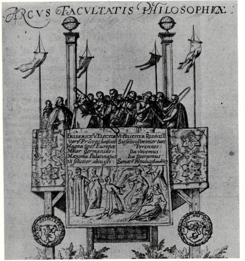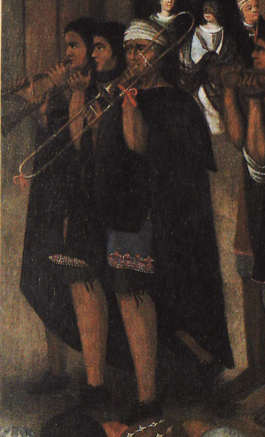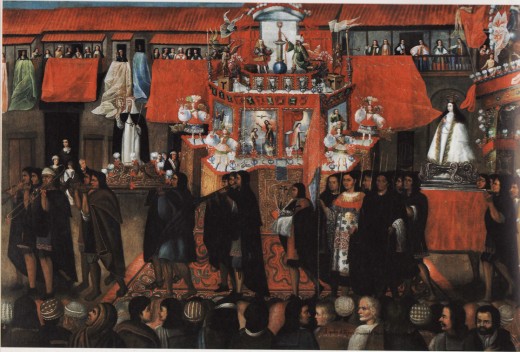Trombone History: The Trombone in Parades, 17th-19th Centuries
This is the second of a two-part series on the history of the trombone in processions. For the first hub, see here.
The trend in the three centuries represented below is a general movement from royal and religious processions toward military processions. Toward the end of this chronology is probably the most famous procession the trombone has been a part of, Beethoven's funeral procession (1827), where the trombones led the procession while playing the composer's Drei Equali for four trombones.
For sources, see Trombone History Bibliography.
The Processions
1601—Wolfenbüttel, Germany: A festival book for Landgrave Moritz of Hesse-Kassel includes an image of an ornately-dressed ensemble of musicians walking in procession, lead by a trombone and cornetto (see below image; public domain) (Dilich 00135)

1611—Mantua, Italy: In a letter from Claudio Monteverdi to Prince Francesco Gonzaga (governor of Mantuan province of Monferrato), Monteverdi reveals that he is trying to help the prince establish a wind band that would include a trombonist. Monteverdi specifies that the musicians of the wind band would "play in private, in church, in procession, and atop city walls; now madrigals, now French songs, now airs, and now dance-songs" (Stevens Letters 81).

1613—Heidelberg, Germany: The trombone's participation in a royal procession consists in playing from a triumphal arch as the procession passes. The welcoming festivities for Elector Friedrich V of the Rhine Palatinate and his Bride, Princess Elizabeth of England, include a series of triumphal arches constructed along the streets by the faculties of the University of Heidelberg. At the first arch, staged by the Faculty of Philosophy, “pleasing music was [performed] by trombones and cornetts.” The festival record continues,“His Highness the Elector, as well as his spouse, were received with a cordial and very lovely musical [performance with] all kinds of string-playing and [other] instruments. Up high [on the stage] stood an angel who blew on two [sic ] sackbuts….When His Highness the Elector, as well as the princes, were escorted in the procession by the four faculties of the world-famous University of Heidelberg, [they] passed through four triumphal arches [surrounded by] many well-wishers. Upon the first archway, which was hung with tapestries, sweet music by sackbuts and cornetts was presented” (Bowles, Musical Ensembles 188). A graphic representation of the welcoming ceremonies depicts a group of musicians, including three trombones, performing on a triumphal arch (see above image; public domain) (Bowles, Musical Ensembles 190).
1615-16—Brussels, Belgium: Archduchess Isabella visits Brussels and subsequently commissions several paintings to portray the related celebrations. Denis van Alsloot, painter for the archdukes of Brussels, depicts a “procession of guilds.” The “loud” instruments pictured, which include a trombone, cornett, curtal, and three shawms, presumably constitute the civic wind band of Brussels. They occupy a place of honor between the relics and the statue (Denis van Alsloot, Procession en l’honneur de Notre-Dame du Sablon a Bruxelles le 31 mai, Museo Prado, Madrid) (see first detail, below; Lesure 94-95; Forney, Antwerp 363; Whitwell, Baroque 181; Wangermée, vol. 1 241). Public domain image. Another artist, Antoine Sallaert, also depicts the procession, portraying the wind band in nearly the exact same posture and configuration as Alsloot, then in a slightly different configuration (see second detail, below; public domain).


1616—Stuttgart, Germany: Festivities celebrating the baptism of Prince Friedrich von Württemberg feature trombone extensively. First, at the service itself, the “Assum Version” festival book records, “The charming piece by Gregor Aichinger, Laudate Dominum &c . for eight voices, with two cornetts, four trombones and two bassoons was executed by the most select vocalists, ending most appropriately.” Following the baptism, a Te Deum by Salomon is sung, utilizing three ensembles: “The first, with a positive organ, four fiddles, two lutes, a small pipe and large contrabass viols, besides four singers. The other, with regal, one cornett, two trombones, a bassoon and four vocal soloists. The third also with a regal, three trombones, a serpent, in addition to four musicians. Whenever the three ensembles played together [there was added] the great organ, a cornett and a contra bassoon [Pommerten Vagoten ].” Later, trombone is again involved, this time during a banquet: “For this, the Kapellmeister of the prince directed a warm, intense chamber and banquet music for the assembled company with select members of the ensemble, in the Italian, English and French manner, with instruments [such as] portative organ, cornetts, trombones, bassoons, lutes, fiddles, viole bastarde , small pipes and live voices, the best soloists, [all] in various combinations.” Two days later there is a procession incorporating instrumentalists dressed as the Nine Muses that includes a trio of trombone and two cornetts (See below image; public domain) (Bowles 199-200, 207).

1616—Halle, Germany: As part of festivities celebrating the baptism of Sophie Elisabeth, first daughter of Markgraf Christian Wilhelm of Brandenburg, there is an enormous introductory procession that includes a group of three gypsies on horseback, escorted by a musical trio of two viol players and a trombonist (see below image; public domain) (Bowles 203, 220).

c. 1625—Lübeck, Germany: As part of the city’s extensive ordinances for musicians, weddings are allowed to include processions to and from the church, accompanied by trombones decorated with banners (Buelow, Protestant 203).
1654—Paris, France: Records of the coronation of Louis XIV at the cathedral of Reims describe a procession that includes wind and percussion instruments: “The king was escorted to the cathedral…preceded by a dozen trumpeters, drummers, fife-players, oboists, flutists, bagpipers and trombonists, all dressed in white taffeta” (Bowles, Musical Ensembles 281).
1674-80—Cuzco, Peru: An anonymous painting, Confraternities of Saint Rose and La Linda, part of a group of paintings called The Procession of Corpus Christi, depicts an Andean trombonist among several wind players. The musicians accompany the statue of Saint Rose as part of a long procession through the streets of Cuzco. The trombonist has what appears to be a decorative red bow tied to the end of the slide, as well as a white cord around the rear portion of tubing (see detail and full image below; public domain) (Cuzco, Museo del Arzobispo) (Wuffarden pl. 14; Baker, Imposing Harmony 38; Baker, Music at Corpus Christi).


1676—Rome, Italy: The pifferi of Rome changes from five trombones and four cornetts to six trombones and three cornetts. They perform during meals of the Conservatory and Priore, in church services, in religious processions, etc. (Kurtzman, Trombe).
1690—Freising, Germany: Trombones are featured in a procession to a tournament celebrating the installation of Joseph Clemens, Archbishop of Cologne and Bishop of Regensburg, as Bishop of Freising. The trombones belong to a group representing Neptune and four tritons (two cornetts and two trombones); see below image; public domain (Bowles 383-86).

1685—England: The choir of Westminster is followed in a procession by three of the King’s musicians, two sackbuts and a double courtal, all dressed in “scarlet mantles” (British Chronologist, 316; Langwill, Curtal).
1761—London, England: The Royal Magazine or Gentleman’s Monthly Companion prints “A Succinct Account of the Coronation of their most Excellent Majesties King George III and Queen Charlotte, on Tuesday the 22d of September 1761.” The description of the procession leading from Westminster Hall to the Abbey includes two Sackbuts situated on either side of “A double Courtal” (Succinct Account 109-110).
1781—Vienna, Austria: Berlin critic Friedrich Nicolai witnesses a Trinity Sunday procession, beginning at St. Peter’s Cathedral, that includes a chorus accompanied by cornetts, two trombones, and two bassoons (Mac Intyre 14).
1789—Rome, Italy: The occupying French replace the Concerto Capitolino, an ensemble consisting of two cornetts and three trombones, with a military band. The ensemble, which had led Papal processions through Rome, had been one of the latest examples of the coupling of trombones with cornetts (Baines, Brass 118).
1804-1815—France: A military illustration labeled French Napoleonic Band depicts the foot grenadiers of the 1st Regimental Imperial Army Old Guard, including two trombonists marching with buccin-style instruments (trombones with dragon-head bells) (see detail and full image below; public domain) (Cassin-Scott and Fabb 15).


1827—Vienna, Austria: British traveler Edward Holmes attends a church service, where he is impressed with the trombones: “After the requiem was finished, a whole procession of priests and choir paraded the cathedral, at distant intervals chaunting [sic] a Gregorian phrase, accompanied by four trombones, and I have heard nothing comparable to the delicious effect these instruments produce when heard at a distance in the cathedral; their tones are so softened in the space, and they join in the gradual swell of voices upon the silence with a sweet severity. Well might the hearer who had found a seat in the choir remain listening to their echoes as they died away in those arches, and cherishing the expectation of a fresh burst” (Holmes 140-141).
1829—Antwerp, Belgium: British traveler Vincent Novello hears Haydn’s Sinfonia in B-flat during the processional at the church of St. Jacques. Although the piece does not originally call for trombone, at least one is apparently used, as Novello is disappointed by the performance: “…it is in a very elevated style of writing and full of energy. Effect spoiled by the Trombone nearly ½ a tone too flat throughout” (Novello 289-90).
c. 1829—Mainz, Germany: Artist Joseph Scholz depicts a group of four military musicians of the Prussian Army on horseback in an image titled Preussisches Heer–Garde Artillerie (see below detail of trombonist; public domain) (Ryan, Paper Soldiers).

1825—Hanover, Germany: Sir George Smart, a British traveler, attends a parade, where he hears several military bands that include trombone: “There was a mixture of bands on the parade, namely the guards band in white, the artillery in blue and the rifle band in a sort of dark green. Their instruments were chiefly bugles and trombones, besides drums and fifes, altogether they numbered about one hundred and fifty. I did not hear them play together” (Cox 203).
1825—Belgium: Sir George Smart, a British traveler, observes, “We heard a very good military horse band which was all trumpets, bugles and tromboni” (Smart 66).
1827—Vienna, Austria: Beethoven’s trombone quartet, Drei Equali , is performed at his own funeral procession (a trombone quartet alternates with a vocal version retroactively set with a Miserere text). A contemporary watercolor by Franz Stöber depicting Beethoven’s funeral shows 4 trombonists leading the enormous procession.
c. 1830—Vienna, Austria: K.k. Österreichischer Militair Leichen-Conduct, lithograph no. 8 from a series edited by Michael Tretsentsky, shows a military band that includes trombones with both traditional and rear-facing bells (see below image–click image for larger version; public domain) (Pirker).

1840—France: A print depicting a Napoleonic military band includes what could be a buccin-style trombone (dragon-head bell) (see far left of below image; public domain) (Brenet 125). For a similar image, see 1804-1815, above.

c. 1850—Brussels, Belgium: Musicien et trompette de cuirassiers, a lithograph by Henri Hendrickx, portrays a Belgian infantry musician playing on what may be a rear-facing trombone, the bell obscured by the player’s helmet (see below image; public domain) (Bibliotheque royale Albert I; Wangermée vol. 2, 263).

1870—Turnov, Czech Republic: An engraving after a drawing by A. J. Levy (1845-1897) portrays a trombone playing with a brass band in the public square in Turnov (see below image; public domain) (Volek plate 347).

c. 1885—Norway: A wood engraving titled A Gay Procession, signed by Günther, depicts what is probably a wedding procession in the Norwegian countryside. A trombonist leads the way, accompanied by trumpet and horn (see below image; public domain) (source: New York Public Library Digital Gallery).

More Trombone History Hubs
- Trombone History: The Trombone in Parades, 15th and 16th Centuries
76 trombones led the big parade! When Meredith Willson penned those lyrics in 1957 for the Broadway musical The Music Man, the author was unwittingly reflecting not just a recent local tradition, but nearly... - Christmas Bells Are Ringing: The Trombone and Christmas throughout History
It's early September as I write this, but one of my children recently put up her Christmas list on the fridge. It's never too early, I suppose! Which got me thinking... As I mentioned in another article,... - God Save the King! The Trombone in Coronations throughout History
The trombone has long been associated with special occasions, including water processions, parades of various types, weddings, various religious celebrations, and coronations. Historically, trombones were for... - Trombone History: Trombones in Water Processions
A brief history of the trombone in water processions. Trombone history in the late Renaissance and Early Baroque. - Trombone History: A Mischievous Trombonist in Renaissance Italy
Siena, Italy, ca. 1572, from Civitates Orbis Terrarum Sixteenth-century, Siena, Italy, boasted a first-rate musical establishment in both its Palace wind band and its cathedral musical establishment,... - Trombone Names Throughout History
The trombone, an instrument that originated in the 15th century, has a long history of colorful names. What other single instrument can boast nomenclature as interesting and varied as sagbot, shagbolt,... - Trombone History in Latin America, 1500-1750
Latin America normally gets only a few pages, at the most, in the standard histories of the trombone. It probably deserves more. Records document a significant amount of trombone activity in colonial Latin... - Sound Qualities of the Early Trombone: 20 Primary Sources
A few years ago I applied for funding to purchase a set of sackbuts, or early trombones, for my university. I decided at the time to do some research, in the form of both recordings and primary sources, into... - How to Hold a Sackbut: The Grip of the Early Trombone in Pictures
Occasionally there is discussion about how the sackbut, or early trombone, should be held. Among other differences, in contrast to the modern trombone, the stays on these early trombones are flat, so the... - Super Slides: Trombones with Extension Handles
Before bass trombones had valves to access extra tubing for lower notes, players were forced to use extra-long slides if they wanted to extend the lower register. These slides were long enough that extension... - Females in Trombone History, 1500-1900
The idea that females did not become serious trombone players until the 20th century is a misconception. While many of the visual images shown below are symbolic (e.g., depictions of muses and angels), there... - Angel Trombonists Throughout History: 40 Images
"What do the angels, those heavenly and most perfect musicanti, play other than these? For if we encounter something about music in the Scriptures, we hear either of a trumpet or a trombone (Kuhnau, 28). ... - Trombone History: Cherubs Playing the Trombone
In visual art, a cherub, or more strictly speaking, a putto, is an infant or toddler, almost always male and with wings, found especially in Baroque art. So what are they doing playing trombone? The main...








